Dodgeball Academia Review
Sports and RPGs are not often married together in video games. Camelot’s Mario Golf entries on the Gameboy Color and Gameboy Advance are some of the most well-known examples, but others have recently revisited the concept with Golf Story and, in its own way, Supergiant’s Pyre. Dodgeball is not commonly seen in games these days either. A personal favorite of mine is 2008’s Super Dodgeball Brawlers from the Kunio-kun series, though the occasional notable dodgeball game still releases once in a while like the excellent Knockout City.
Then, what would a dodgeball RPG look like? How would the rules of dodgeball translate into a modern RPG?
Brazilian indie studio Pocket Trap explores this strange possibility intricately and lovingly with their most ambitious project yet, Dodgeball Academia.
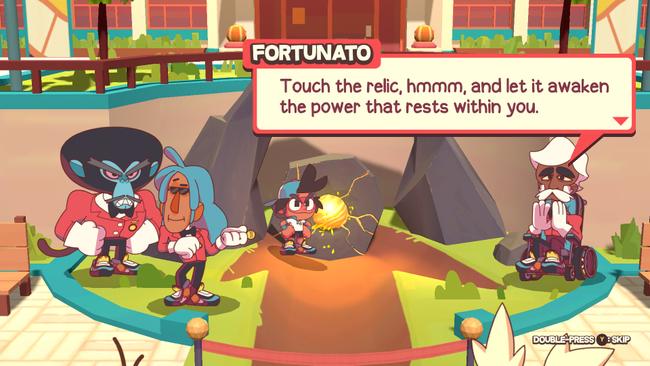
Upon first glance, I could not help but notice how charming Dodgeball Academia looked. It feels like a Cartoon Network or Nickelodeon show came to life; the game’s vibrant Saturday morning cartoon aesthetic oozes personality and attitude. Even long after beating Dodgeball Academia, I still think about how much it captured the creative spirit of '90s cartoons. There are a lot of neat systems that fluidly meshed the expectations of what a RPG should have with common dodgeball rules.
Dodgeball Academia revolves around Otto, a rebellious boy who stumbles into the world of dodgeball against his parents’ wishes. In order to remain at this odd school, Otto is faced with an ultimatum - win its team dodgeball tournament or disenroll to continue what his parents want him to do in life. He quickly finds himself in all sorts of problems surrounding the school as he searches for teammates and learns counter strategies against his opponents in the tournament.
Players participate in up to 3-vs-3 real-time battles throughout Otto’s quest. As one might expect, everything revolves around exchanging blows with dodgeballs. When combat encounters begin, several dodgeballs are usually lined up in the center of the court and both sides have to make a mad dash toward them to gain the initiative.
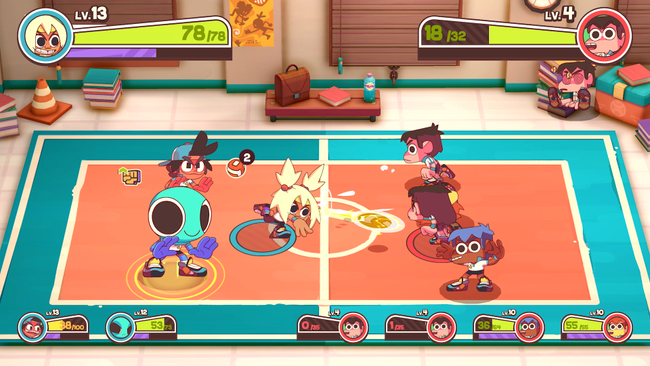
Some liberties were taken with the sport of dodgeball to have it fit within the mold of an enjoyable RPG experience. A prominent example is that getting hit by a single dodgeball doesn’t spell the end of a participating combatant. Instead, everyone has their own lifebar and successful dodgeball hits inflict damage to that; of course if that life bar is diminished, then that’s when a combatant can no longer participate in the forefront. They are either excluded for the rest of the match or, in some cases, carry on from behind the opposing side’s team to keep them on their toes. Players and foes can also hold multiple dodgeballs at a time.
This simple foundation is the heart of Dodgeball Academia and several inventive elements help shake it up.
All party members and some special enemies have their own super attack, referred to as the Balltimate Move. Players charge up their Balltimate meter throughout battles by dealing damage and successfully catching or countering an incoming dodgeball throw. These moves are quite powerful and often turn the tide of battle; Otto throws out a Shinku Hadouken of Street Fighter fame, Mina calls upon lightning strikes guided by the player, and Balloony places a water healing field where all party members regenerate health simultaneously for a limited time, for instance. Meanwhile, enemy Balltimate moves often transform the battle into a bullet hell game.
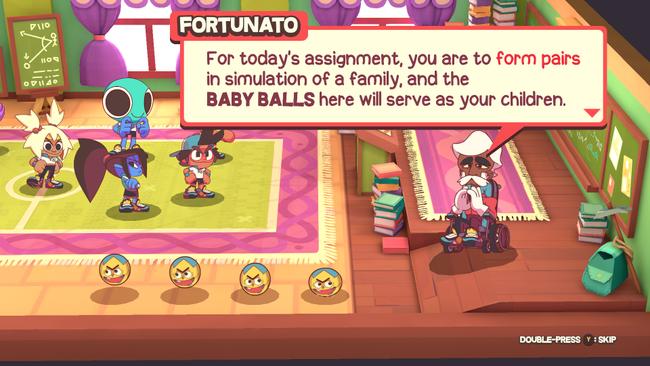
Pocket Trap has also found a way to make each party member distinguishable by tailoring their growth to fit a role that traditional RPGs would have. As they level up, each member possesses special skills that can be charged up and utilized when a dodgeball is on the opposite side of the court. Balloony would be the “white mage” of the player’s dodgeball party not only because of his Balltimate move, but also because his unique skill lets him burst heal the party if he manages to charge it up. Suneko buffs herself at the cost of decreasing her defense, and Shoy specializes in debuffing the enemy’s Balltimate Move meter build-up. Some characters can also apply elemental afflictions to dodgeballs with charged throws, along with altering how they throw them as well. For instance, balls thrown by Balloony later on travel in slower, circular motions rather than a fast, straight line.
One of the weaker aspects in Dodgeball Academia for me was in its character progression. Party members automatically learn new techniques when they reach certain levels, yet they’re mostly unsatisfying by and large. These usually just add some sort of property to a character’s normal throw, special skill, or Balltimate move. For example, Otto’s normal throws eventually all become tinged with fire rather than having to infuse them manually via charging a throw or how his Balltimate Move will become a tad larger. It never felt gratifying to earn these new tweaks, once I caught onto the trajectory of character progression early on. They do come in handy every so often, though I really would have liked to see the occasional brand-new ability to further flesh out the party.
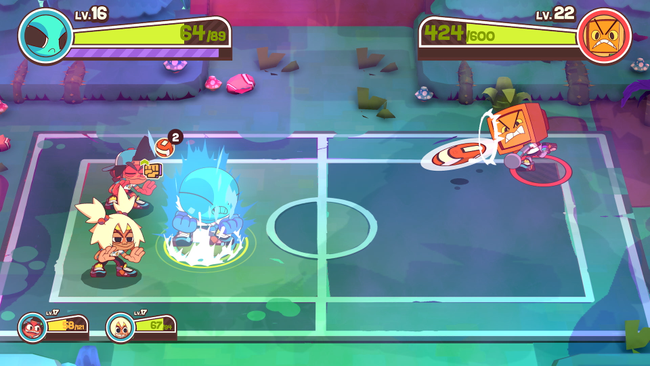
Further modifiers are introduced in dodgeball arenas themselves. Some battles may have special types of dodgeballs that inflict ailments on contact, like a poison dodgeball, or the ground itself may be obscured due to tall grass. The special dodgeballs in particular do vary the game up a fair bit, but the repetitive battles in the back third of the game dragged it out on top of an already padded last stretch.
Most of Dodgeball Academia’s sidequests weren’t that impressive either, usually having Otto’s gang finding items gated behind some fights. A particular one that I wish the game had more of involved a bathroom and literally imagining how dodgeball would play out in a more traditional turn-based RPG battle system. It was a welcome respite among the sea of similarly constructed sidequests.
I did appreciate that Pocket Trap let Otto borrow Sonic the Hedgehog’s Spin Dash to move around the school rapidly though; it even has an oddly similar sound effect. The layout of the school is not too large and players will explore other bordering areas besides it. There is a bit of a Pokémon approach to its overworld travel as battles come in the way of wandering dodgeball players looking for a match as they spot players and a medical center ready to attend to the party’s bruises at any time. The in-game UI also helps convey the upbeat '90s cartoon personality as well. Vibrant menus and a clearly marked, easy-to-use map makes navigating a breeze.
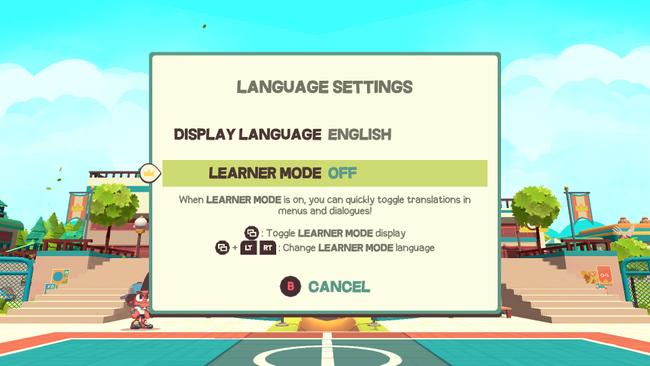
A neat feature in Dodgeball Academia is its toggleable language Learner Mode; the game’s script supports eight different languages and with Learner Mode, players can quickly swap between each of them mid-game on every single menu and line of dialogue. It’s a handy tool if people want to brush up on languages they are currently, or interested in, learning. Plus, Learner Mode also gives curious individuals an easy method to observe how certain dialogue was localized into other languages. Learner Mode is certainly a feature I would love to see in more RPGs moving forward.
There is also a local versus mode in Dodgeball Academia if players want to test their skills against one another. Characters are continually unlocked for it as players progress through the story and some characters that normally don’t join Otto show up as playable characters in versus mode. Players can toggle how many rounds, what type of dodgeballs, which stage, and teammates for it.
Dodgeball Academia is simply lovely with all the little touches it puts forth to celebrate both RPGs and the sport of dodgeball. Many clever mechanics make the marriage between the two a natural fit in this game. Some unsatisfying character progression, late-game repetitive battles, and a needlessly prolonged final stretch do set it back, but I think it is still a solid attempt at such a novel concept.